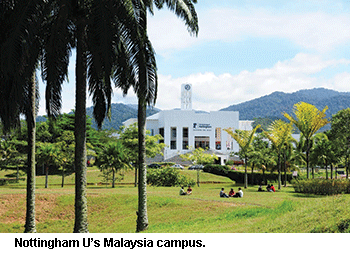 For almost 30 years, branch campuses set up by foreign universities have been a central part of Malaysia’s higher education strategy, and it now hosts outposts of 12 overseas institutions. It’s an approach that has helped to establish the country as a leading international education hub, boosted by its proximity to south-east Asia’s star education performer, Singapore. The strategy has also been aided by Malaysia’s relative political stability.
For almost 30 years, branch campuses set up by foreign universities have been a central part of Malaysia’s higher education strategy, and it now hosts outposts of 12 overseas institutions. It’s an approach that has helped to establish the country as a leading international education hub, boosted by its proximity to south-east Asia’s star education performer, Singapore. The strategy has also been aided by Malaysia’s relative political stability.
However, this approach is under scrutiny after the defeat in May of the dominant Barisan Nasional coalition for the first time in 60 years and the ousting of Najib Razak, the leader of the coalition’s dominant party, the United Malays National Organisation (UMNO). He has been replaced by former UMNO leader Mahathir Mohamad, who now heads the Pakatan Harapan coalition.
Najib had been a firm backer of the branch campus strategy as prime minister and in previous government roles. As an alumnus of the University of Nottingham, as education minister he likely played a key role in its establishing a base in Malaysia in the 1990s.
Morshidi Sirat, senior research fellow at Malaysia’s National Higher Education Research Institute, based at the Universiti Sains Malaysia in Penang, says that Najib may have been the “primary mover” in supporting new branch campuses as prime minister, but that the strategy was always much wider than one politician and it has been scaled back in recent times anyway. Referring to the original motivation for the strategy, he says “while Malaysia has several good public universities almost all… were not successful in attracting international students at the undergraduate level as these institutions use Malay language as the medium of instruction”.
As time has gone on, the branch campuses have also increasingly attracted domestic students, especially those from Malaysia’s ethnic Chinese and Indian communities who found it difficult to access the public university system. In part, this was because of a quota system introduced in the past as part of an “affirmative action” policy of getting more students from Malaysia’s indigenous bhumiputra population into the system, says Prof. Morshidi.
However, as branch campuses have attracted more domestic students — increasingly including those from middle-class bhumiputra communities — this has also indicated “that they have not been able to attract substantial numbers of international students”.
A “moratorium” on new higher education institutions had begun in 2012, says Morshidi, and although this did not cover the EduCity Iskandar development near the Singapore border, even this location is becoming full. Ka Ho Mok, vice-president and Lam Man Tsan, chair professor of comparative policy at Lingnan University Hong Kong, says that one possibility is the opening up of the public system to more Indian and Chinese students, which could lead to “keen competition” with the branch campuses.
But potentially more important, he said, would be the new government’s attitude over how to meet the demands of Malaysia’s labour market. “If the labour market favours locally groomed graduates, those who graduate from the branch campus may be (in a) disadvantaged position,” says Prof. Mok.
Certainly, with the political situation still in flux, and Malaysia having already gone some way towards reaching its goal of being a major higher education hub for the region, it seems that further branch campuses are unlikely. And for his part, the head of Nottingham’s Malaysia campus, Graham Kendall, says he thinks there should be a period of reflection. “I think that there should be a halt, while Malaysia takes stock of what it has, and where it wants to go. It is arguable whether we have reached saturation point — but a stocktaking period would be useful,” says Kendall.